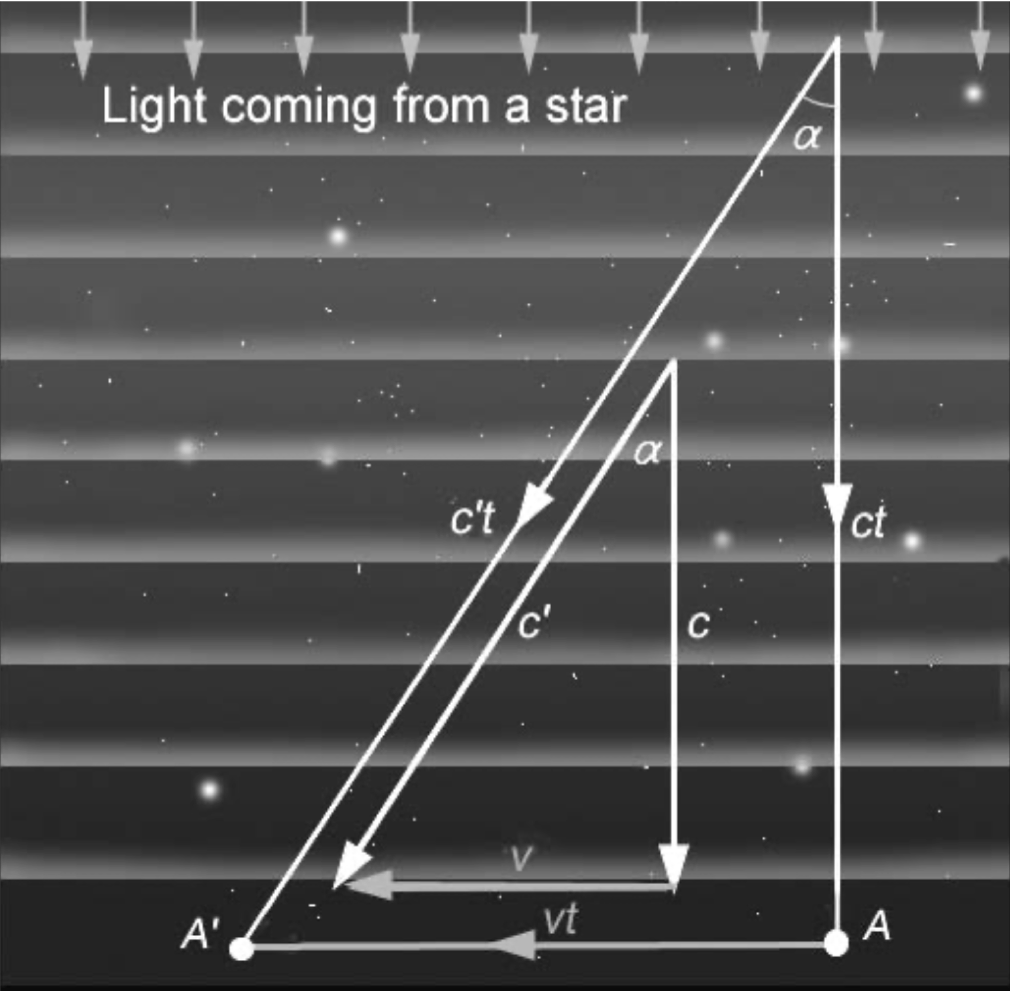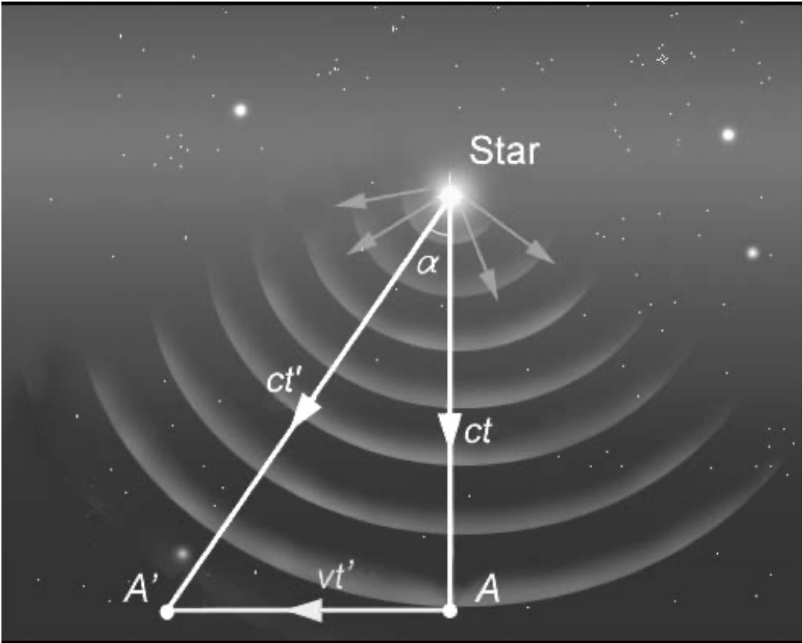The Life and Death of the Aether (Part IV)
The Abominable Aberration of Starlight
This is the fourth installment of an ongoing saga concerning the history of the aether. Where possible, I’ve included the words of the relevant scientists that sought cause for the invisible actions-at-a-distance — light, electromagnetism, and gravity. For several thousand years, the search for mechanism centered on this mysterious, yet undetectable substance called the aether. Please start at the beginning of the story, so as to frame all that follows appropriately.
Last time, we went deep into the civil war that gripped physics over the nature of light. Wave theorists were continually thwarted by their relentless reliance on the failed analogy of light to the longitudinal waves of sound. Eventually, the triumvirate of Huygens, Young, and Fresnel brought forward the conception of light as a longitudinally propagating transverse oscillation. Even so, corpuscularists had one last ace up their sleeve: the abominable stellar aberration.
As we shall see, from here on out, the aberration of light has been a nightmare for physicists since reported in 1728. James Bradley, a professor of Astronomy at Oxford, was attempting to measure the parallax of light on opposite sides of our planet’s orbit from a distant star. Parallax is the effect you can experience right now by focusing on these words with only one eye at a time — you notice the apparent position of the words shifts right or left of center, ever so slightly. Parallax is due to uncentered observation.
Instead of finding parallax (which proved extremely small on account of the relative distances to the star vs. the diameter of the Earth’s orbit), Bradley noted something even more bizarre: He found a shift in apparent position which occurred exactly opposite parallax, out of phase by 90 degrees. The distortion of signal is extremely slight — 20 arcminutes. That is 20/3600 of a degree. Even today, the aberration is so slight that it is not taken into account when calculating star positions by NASA.
The standard version of the stellar aberration. A telescope is tilted into the earth’s direction of motion. Image credit.
Bradley discussed happening upon the aberration for the first time,
“It was chiefly therefore Curiosity that tempted me (being then at Kew, where the Instrument was fixed) to prepare for observing the Star on December 17th, when having adjusted the Instrument as usual, I perceived that it passed a little more Southerly this Day than when it was observed before.”
What Bradley observed was an aberration of light that occurred only as the Earth became perpendicular to the source during its orbit about the sun. The speed of light was a hot topic, for Roemer had quite recently demonstrated the finite speed through his observations of Jupiter’s eclipses, which appeared early when Earth was near and later as we were far. Hence, Bradley looked at the perpendicular location of the Earth during aberration and imagined the lateral contribution of the Earth’s speed to the velocity of light.
The Earth’s orbital velocity had been known for quite some time, and Roemer/Huygens contributed the speed of light to the calculation. From there, it was a simple trigonometric deduction, using each of these speeds as velocity vectors on a triangle to back-calculate the angle of aberration. In Bradley’s own words,
“[the aberration] proceeded from the progressive motion of light and the Earth’s annual motion in its orbit. For I perceived, that, if light was propagated in time, the apparent place of a fixed object would not be the same when the eye is at rest, as when it is moving in any other direction, than that of the line passing through the eye and object; and that when the eye is moving different directions, the apparent place of the object would be different.”
The basic right triangles set up by Bradley, with vector addition of Earth’s motion, v, and light speed, c, to yield c’. Image credit.
Bradley’s basic idea seems sound enough. It is often described as analogous to running in the rain. When you stand still the drops come straight down, but when you sprint into them, they appear to come at an angle (in reality you’re running into the sides of the drops so the experienced pressure vector is at an angle). This explanation put Bradley squarely in the camp of the corpuscularists. It proved quite easy to deduce the aberration when assuming a star fired a bullet-like drop of light from a given location — presuming light corpuscles like this, the angle of aberration simply described the former location of the emitted light. But the corpuscularist victory would not last long.
On the other side of the Channel, trouble was brewing. We learned last time that Fresnel had essentially won the world over when he mathematically united the notions of interference from Young with the Huygen’s wave theories. One of Fresnel’s collaborators from that period was Francois Arago. The French corpusculist, Pierre-Simon Laplace, commissioned Arago to look into some astronomical matters. Laplace was quite sure that the gravity of large bodies would retard the speed of light, and so asked Arago to check it out (for this initial speculation about the interaction between of gravity and light, Laplace is often credited with being the father of Black Hole-ology).
Instead of recording gravitational effects of light, Arago found a contradiction in the explanation for the aberration given by Bradley. Bradley’s reasoning relied on combining the velocity of the Earth’s orbit with that of light. Arago, however, had found that at six-month longitudinal intervals when the Earth’s motion should add or subtract from a star the most, there was no observable change in the predicted focal length that should result from the added speed in either opposing direction. In a separate experiment, Arago observed the aberration through a very thick prism, which according to the corpuscularists should change the aberrational angle significantly but did not. Light’s speed appeared irreconcilably constant regardless of motion. Bradley’s vector addition was in trouble.
Arago and his colleagues tried desperately to talk themselves out of the constancy of the vacuum speed of light. They imagined, incorrectly, that perhaps there were other rays, beyond those visible, that travel at differing velocities:
“It seems [that] ... one can only explain the observation by assuming that luminous bodies emit rays with all sorts of velocities, provided one also admits that these rays are visible only when their velocities fall between specific limits. In effect, in this hypothesis the visibility of the rays will depend on their relative velocities, and, as these same velocities determine the quantity of the refraction, the visible rays will also always be refracted in the same way.”
Arago turned to his pal, Fresnel to rectify the matter. Fresnel imagined that the aether within the prism did not attain the speed of the prism itself, because it was only partially dragged by the object. This launched a new epic in aether history: The search for the aether drag. This topic is well worth its own post, so I’ll leave the details to our next session. Without getting too far out of sequence, we must recognize that Fresnel’s mathematical formulation of the aether drag is essentially reproduced in Einstein’s Special Theory of Relativity, which is the go-to explanation for the aberration today.
But we have to note that there remain occasionally debated inconsistencies with the relativistic interpretation of the aberration and one might even say that relativity has not quantitatively improved upon Bradley’s conception. For instance, one of the postulates of Relativity is that the speed of light is constant in all reference frames, which obviously rules out additive velocities of light. To get around this, Einstein simply kicked the can down the road to the parameter, time, saying that time itself expands to account for Bradley’s well-documented trigonometric explanation.
Recalling that time itself is a concept to relate the relative motion, or relocation, between any two bodies, one wonders what is meant by the contraction of time itself, if not that one of the reference objects’ motion has slowed. But this cannot be, for we know that under basic relativity postulates, light’s motion cannot be truly additive for an observer. We’ve known this long before relativity, beginning with Arago’s 1810 focal length experiment.
The basic right triangles set up by Einstein, ever-so-slightly differing from Bradley, with vector addition distorted time instead of speed. Addition of speed was outlawed by Arago through his experiments during longitudinal approach and recession from the star. Image credit.
One also wonders why velocity-addition explanations for the aberration only make use of the orbital velocity of the Earth alone. Measurements of binary star systems, confirm that only the Earth’s motion, not the emitter’s motion is relevant to the aberration calculation — this seems to fly in the face of corpuscular ballistic notions of light-as-particle. Edward Eisner, who first advanced the contradiction, defended the relativistic interpretation in the end of his paper. In 1967 Eisner wrote:
“We have shown that the “binary star paradox” is not a paradox at all, but merely a consequence of an erroneous, but commonly accepted interpretation…The fact that we do not see myriads of widely separated binaries in wild gyration does not require any fundamental change of outlook. But it does require that the aberration should be realistically treated as the transformation between the frames of reference of two observers, not a source and an observer.”
There are several resources available for comprehending the relativistic reconciliation with these matters. Here is one of my favorites, which sort of side-steps Bradley’s vector-addition by swapping the combined hypotenuse speed for the speed of light. This rather ad-hoc adjustment allows the relativist to remain in congruence with the light-speed constancy for an observer. As a result, the major cathetus of the triangle, formerly the speed of light for Bradley, then represents the sun’s reference frame. Ironically, either triangle (earth position 1, earth position 2, star) is so elongated as that there is virtually no difference in length between the two legs – remember, the angle of aberration is 20/3600 of a single degree of declination to the horizon. So both calculations work, but Bradley’s elegant reasoning is absent in the relativistic treatment.
The search for rationalizing aberration can grow quite frustrating. I’ve looked far and wide for non-relativistic solutions and my sense is that these must involve lensing at the interface between either the earth and solar system or the solar system and interstellar space. I do wonder if perhaps the apparent depth due to under-explored interfacial lensing could be neatly folded into the observed Bradley relationship by adjusting speed through the optical-distance modulation due to position rather than time dilation due to motion.
Needless to say, I’m terribly dissatisfied with the extant explanations for aberration. All the same, let us press on with the saga and head toward the history of the aether-drag experiments after Fresnel. This will allow us to see how we ended up with Einstein’s ‘space’ after failing to detect the luminous medium. Ironically, in the end, physicists gave up on making sense of the aether. Today, the renowned relativistic conception is touted as a mediatorless explanation for action-at-a-distance. After we make through the history of aether drag searches and up to Special Relativity, we’ll return to why Einstein himself did not actually think of his theory as mediatorless, despite its widespread popularization as being so.










